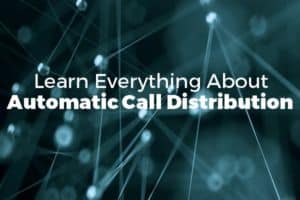What is ACD or Automatic Call Distribution?
An ACD or Automatic Call Distribution System is an essential part of an overall contact center software solution as it connects incoming calls to specific agents who are skilled in specific skill sets. This technology is a component that takes calls and assigns them to the appropriate agent. ACDs are critical in the contact centers, as they assist in meeting the goals and objectives of your business.
The system analyzes inbound calls, creates a detailed template, and assigns specific calls or tasks to assigned agents. A calling process may include taking the caller through an IVR (Interactive Voice Response System) process or forwarding the call to the correct contact center agent.
 An ACD system may be an add-on or a separate component of your contact center solution. You can find out more information about ACD in this blog post.
An ACD system may be an add-on or a separate component of your contact center solution. You can find out more information about ACD in this blog post.
One of the key benefits of an ACD is that it provides a lifeline for a customer who calls and needs help. It can also allow an agent to take over the conversation and handle it with the customer’s preferred language and in a more sophisticated way.
An ACD provides a single, central location where inbound calls are routed to the appropriate agent. Since all the calls end up with the same agent, the logic and rules are established at a central place and updated frequently, rather than each contact center agent having to manually implement routing rules for incoming calls.
Functions and Capabilities of Automatic Call Distribution System
ACD Technology has three basic functions :
- Ability to take control of the conversation.
- Helping an agent determine the best response to an inbound call.
- Routing calls to the right agent to complete the task at hand.
As an example let’s say a client called in for help with a collection-related issue.
In a classical call center, an agent answers the call and tries to figure out what the customer needs help with. Then, he connects to the support department that can help. An ACD could automate this process and route the call to an agent specialized in collection, who could take better care of the customer.
How can the ACD help agents?
 As a contact center agent, you’re always managing incoming calls in some way. If you’re not looking at the caller’s status, which number they’re calling from, or how many agents have handled the call before, you’re probably not focusing on the customer.
As a contact center agent, you’re always managing incoming calls in some way. If you’re not looking at the caller’s status, which number they’re calling from, or how many agents have handled the call before, you’re probably not focusing on the customer.
ACD technologies can help you focus on customer service by saving you from having to manually take control of the call, as well as providing a better experience for the customer. Not all contact centers will have ACD systems in place as it depends on how advanced their system is. However, with a basic ACD, it is easy to see the benefit it provides.
How can the ACD enhance campaigns?
- Inbound calls are not directed to an agent depending on their availability, but rather to one who has the requisite expertise and can better respond to the customer’s needs.
- Calls will be routed to the most suitable agents as soon as possible, based on preset criteria, with a prompt answer if the agent in question is available. The call will be put in a queue if there is no agent available.
- Before answering the call, agents will display client data such as history, ensuring that the interaction with the customer is well-structured.
- Allows for various site connections. Calls can be conveniently forwarded to agents in various regional regions, and it would act as if they were both part of the same unit.
- If no agent is available, the customer may either wait in a queue or request a callback, in which case the agent will call him back as soon as one becomes available.
- Supervisors have constant online oversight of their agents (the ability to activate/deactivate, listen to conversations, whisper to agents, and even interfere in them).
- Extensive metrics to determine a contact center’s performance: the number of rings before the start of a chat, the length of communications, the customer’s wait time on the phone, the number of calls taken, handled and abandoned by an employee, and the number of operators associated.
What are the advantages?
 A cloud-based call center automated distribution solution routes calls to traditional contact center software or call center software. Automatic Call Distribution (ACD) is a truly integrated call center solution that uses a mix of software and standard call center hardware and services.
A cloud-based call center automated distribution solution routes calls to traditional contact center software or call center software. Automatic Call Distribution (ACD) is a truly integrated call center solution that uses a mix of software and standard call center hardware and services.
The total configuration time is significantly reduced for this form of a solution, as ACDs can take far less time than manual call delivery. When compared to manual call delivery, ACDs offer several advantages, including lower call center costs and staff hours, improved judgment precision, and increased reliability and quality.
What is the application of ACDs in call centers?
Call center tech underpins ACDs. This ensures that a virtual contact center is created by combining software and hardware. ACDs have the ability to handle multiple calls and multiple subscribers at the same time, which is one of their main benefits.
ACDs are capable of handling call volumes of up to 10,000 or more per day. They can be used for collections, sales, marketing, customer support, and staff management, among other things. ACD is also capable of providing flexibility and assistance to an operation depending on the organization’s evolving needs. ACDs allows for a greater range of channel counts to be considered.
What is the software used for ACDs in contact centers?
 The contact center software is used to deploy ACDs. Any ACD solution comes with all of the requisite contact center tools, including the contact center program that manages call routing, the database, call center software, and call monitoring software. ACDs are built on the basis of information systems.
The contact center software is used to deploy ACDs. Any ACD solution comes with all of the requisite contact center tools, including the contact center program that manages call routing, the database, call center software, and call monitoring software. ACDs are built on the basis of information systems.
The database system contains the client’s information. This system has the responsibility of storing the contacts, customer information, call activity, and status. It also performs primary functions such as calling and routing calls to call centers. The database system is by nature, a software-based technology that has an interface with the underlying business systems of the organization. Such as enterprise resource planning, customer relationship management, and workforce management systems.
How does it work?
The ability to recognize callers within a network by connecting them to a database is important for automated call delivery (ACD). This database can keep track of a call handler’s current actions as well as the outcomes of past calls, allowing for automated call assignment.
The ACD then uses the database to find the caller.
As far as CTI is concerned, the combination of telephony and IT is carried out seamlessly. This combination is a very popular technique in the world of contact centers. Since it is from a CTI server that all the different types of communication on the Internet converge. This includes telephone systems, websites, email, fax, and all types of communication channels.
This process is completed by the controller making a phone call and following the basic directions given by the calling client. The call is then rerouted into ACD, which links the caller to the ACD center.
What about other software?
 A contact center’s reliability and profitability are not dependent on a single IT tool. The PABX, CTI, and IVR all work in tandem with the Automatic Call Distribution System.
A contact center’s reliability and profitability are not dependent on a single IT tool. The PABX, CTI, and IVR all work in tandem with the Automatic Call Distribution System.
The PABX is responsible for connecting all of the telephone sets to a single telephone line. The PABX, also known as a lock, is responsible for the configuration of voice mail as well as connections to internal telephone lines, including calls from outside. Then, the ACD distributes the calls on each telephone line according to the needs expressed.
The CTI or computer telephony integration then creates a connection between telephony and data processing for him. In the world of call centers, this mix of telephony and IT is a very common technique. Many of the various forms of media on the Internet converge on a CTI server. CTI allows for the use of telephone systems, websites, email, and fax machines, among other correspondence methods.
Finally, the IVR keeps the customer’s conversation online to show them the way ahead. Each caller follows the IVR’s directions to determine which number to dial in order to be connected to the appropriate individual who can address their issue.
The Importance of Rules Within the ACD
 Rules are computer instructions that decide the agent will answer a call, how that agent will respond to the call, and the next steps in the process of linking the customer to that agent, equivalent to an algorithm.
Rules are computer instructions that decide the agent will answer a call, how that agent will respond to the call, and the next steps in the process of linking the customer to that agent, equivalent to an algorithm.
Rules are commonly used in computers to establish several hierarchies so that the ACD code can route calls to the most suitable agent based on a variety of factors such as the agent’s position, location, language, and so on.
These rules are maintained in an ACD system, which logs incoming calls and routes them to the right agent automatically. The ACD server is usually a high-performance, efficient computer system that conducts comprehensive processing for simple routing as well as initiating and terminating calls.
The ACD framework can also contain a variety of layers, such as a database network, a call center management system, and an IP-based network, in which the ACD program operates on a computer server that may be located anywhere the ACD has access.
Highlights
- Contact center traffic will benefit from automated call delivery (ACD). ACD can also handle higher-volume call traffic in contact centers.
- It is intended to reduce the volume of manual call handling in call centers.
- The technology provides you with a single location to capture your call volumes, allowing you to track calls, retrieve call details, and decide on-call management.
- ACD works for a wide range of services, including collections, financing, customer engagement, call center results, and service reviews.
Conclusion
To boost the efficiency of their contact center activities, businesses are turning to tech application vendors. Software as a service is the most recent development for improving a contact center’s overall results. Companies are putting in place tech service vendors to help them accelerate creativity in call center operations.
This technology is built on the organization’s sophisticated business processes. Software application vendors provide software applications that are designed to suit the needs of companies.

Abdelmounim Benharouga has always had a strong passion for writing and digital marketing. He started as a Digital Content Writer part of marketing department then moved to being Customer Success Manager for the African Region within the Nobelbiz team.







